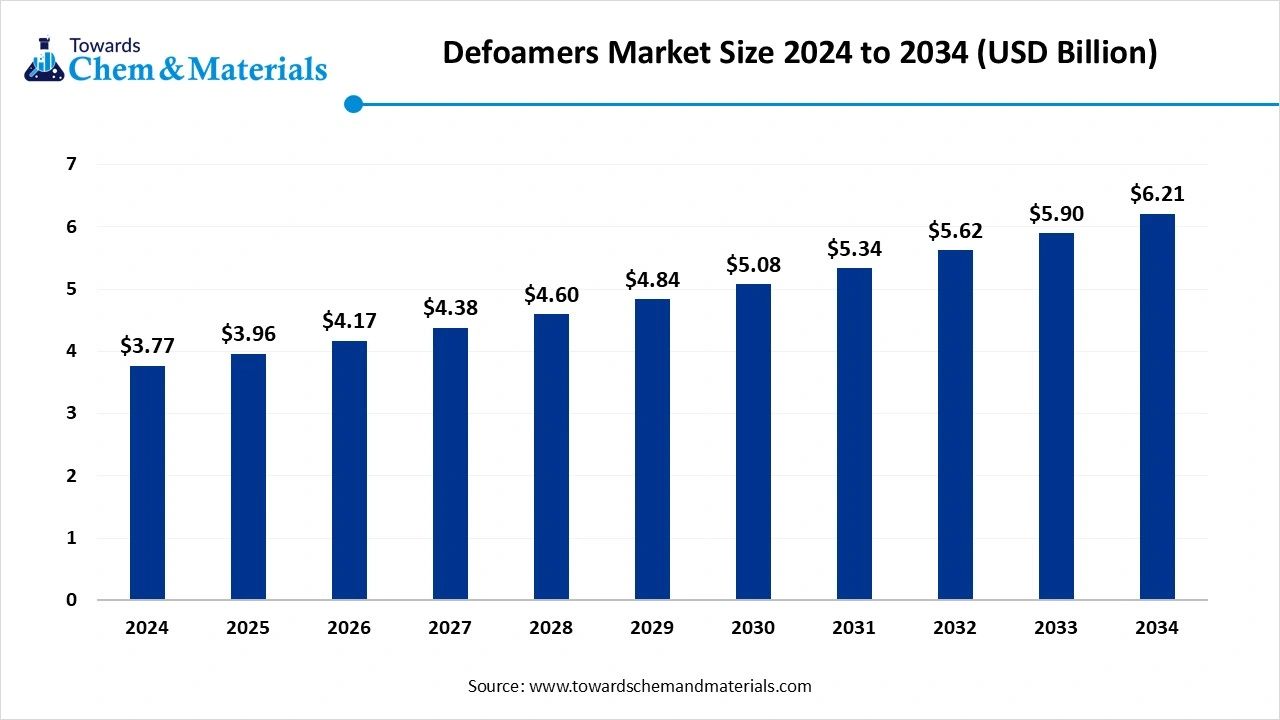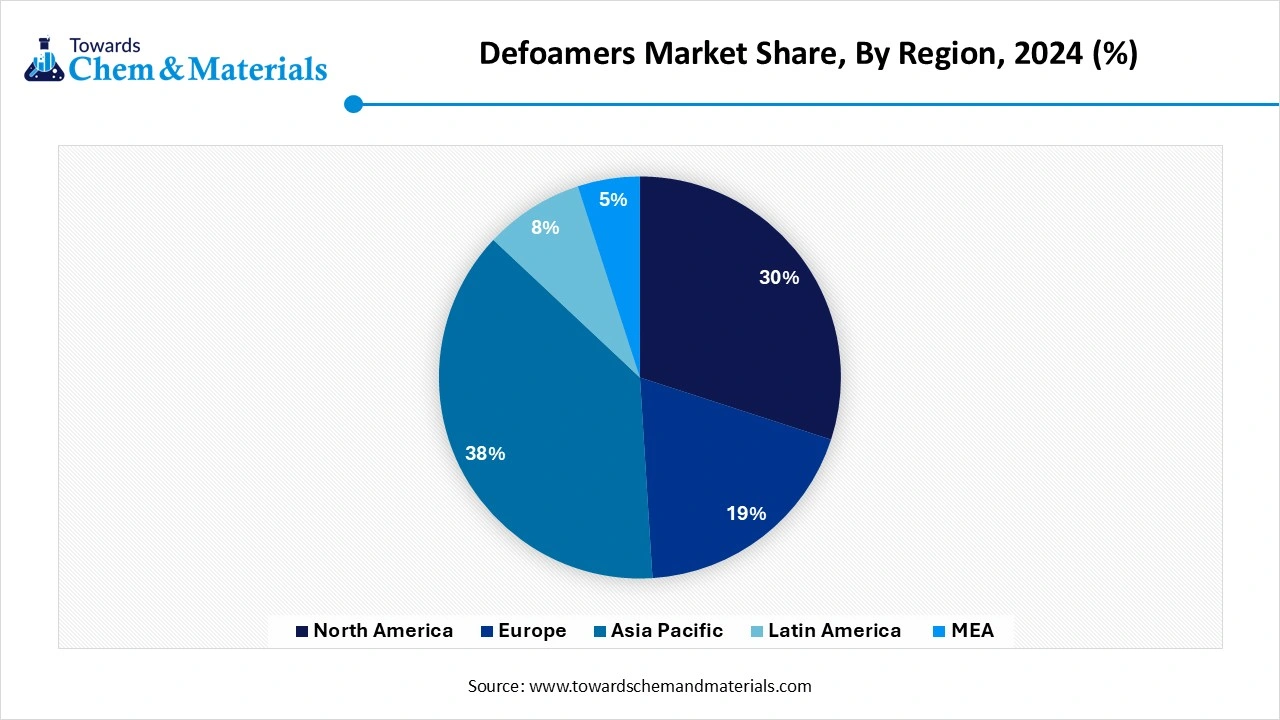December 2025
The global defoamers market size accounted for USD 3.77 billion in 2024, grew to USD 3.96 billion in 2025, and is expected to be worth around USD 6.21 billion by 2034, poised to grow at a CAGR of 5.11% between 2025 and 2034. The increasing demand for agrochemicals globally is the key factor driving market growth. Also, a surge in the need for wastewater treatment, coupled with the rising preference for sustainable defoamers, can fuel market growth further.

Defoamers, also known as anti-foaming agents, are chemical additives that reduce and hinder the formation of foam in industrial process liquids. Foam can cause defects in surface coatings, hinder processing capacity, or result in poor product quality. Defoamers are used across multiple industries, including paints & coatings, food & beverages, water treatment, and pulp & paper, among others. Growing demand in sectors such as pulp & paper, oil & gas, paints & coatings, and pharmaceuticals is positively impacting market growth.
| Report Attributes | Details |
| Market Size in 2025 | USD 3.96 Billion |
| Market Size by 2034 | USD 6.21 Billion |
| Growth rate from 2024 to 2025 | CAGR 5.11% |
| Base Year of Estimation | 2024 |
| Forecast Period | 2025 - 2034 |
| Dominant Region | Asia Pacific |
| Segment Covered | By Type, By Medium/Formulation, By Application Industry, By Function, By Distribution Channel, By End-Use Formulation Compatibility, By Region |
| Key Profiled Companies | BASF SE, Evonik Industries AG, Dow Inc., Kemira Oyj, Shin-Etsu Chemical Co., Ltd., Air Products and Chemicals, Inc., Ashland Global Holdings Inc., Clariant AG, Wacker Chemie AG, Huntsman Corporation, Momentive Performance Materials Inc., Elkem ASA, Solvay S.A., Elementis PLC, BYK-Chemie GmbH (ALTANA Group), Munzing Chemie GmbH, SAGITTA (KCC Corporation), Kao Corporation, Resil Chemicals Pvt. Ltd., King Industries, Inc. |
The growing need for paper-based products from the packaging sector is the major factor creating lucrative opportunities in the market. Defoamers help to decrease the amount of broken paper, which impacts the overall performance of the paper machine. Furthermore, defoamers enhance the quality of the fiber to fuel productivity. It is expected that rising product demand from subsectors like industrial paper and specialty paper will impact market expansion positively soon.
Developing innovative, eco-friendly defoamers with bio-based components and silicone-free molecules necessitates significant investment in testing and technology to maintain high quality, which is the major factor hindering market growth. Moreover, fluctuating raw material prices, particularly for high-quality ingredients, can lead to changes in price and impact overall market profitability.
The Asia Pacific defoamers market size accounted for USD 1.50 billion in 2025 and is forecasted to hit around USD 2.36 billion by 2034, representing a CAGR of 5.14% from 2025 to 2034. Asia Pacific dominated the defoamers market with 38% market share in 2024, and the region is expected to sustain this position during the forecast period. The dominance of the region can be attributed to the rising consumer awareness, surge in regional population, along technological advancements in the industry. In addition, ongoing implementation of environmental regulations and polices around industrial emissions and waste management, coupled with the expansion of the food & beverage industry, will drive market growth soon.

Defoamers Market in China
In the Asia Pacific, China led the market owing to the rapid industrialization, especially in sectors such as water treatment and chemicals, paints & and coatings. Rising environmental awareness and an emphasis on sustainable solutions are also major factors impacting positive market growth. The Chinese government is promoting collaboration among large and medium-sized players to enhance industry competitiveness.
North America is expected to grow at a significant CAGR over the forecast period. The growth of the region can be driven by stringent environmental regulations, ongoing technological advancements, and rapid industrial growth in countries such as the U.S. and Canada. Furthermore, growing regions' emphasis on biodegradable and sustainable developers aligns properly with regulatory needs aimed at minimizing environmental impact.
Who are the Leading Chemical Producing Countries in 2024?
| Country | Production Volume |
| China | 1.3 billion tons |
| United States | 250 million tons |
| Germany | 180 million tons |
| Japan | 120 million tons |
| South Korea | 80 million tons |

Which Type Segment Dominated the Defoamers Market in 2024?
The silicone-based defoamers segment held a 35% market share in 2024. The dominance of the segment can be attributed to the exceptional versatility and performance of these defoamers and their ability to function smoothly in extreme conditions, like fluctuating pH levels and high temperatures, which makes them favourable in many sectors. Additionally, these defoamers provide effectiveness, superior stability, and long-lasting results in diverse applications.
The polyether siloxane-based defoamers segment is expected to grow at the fastest CAGR over the forecast period. The growth of the segment can be credited to the surge in industrial production, rising product demand from end-use industries, and rapid technological innovations in the industry. Also, the low surface tension of polyether siloxane-based defoamers gives the required properties for end-use applications.
Why Emulsion-based Segment Dominated the Defoamers Market in 2024?
The emulsion-based segment led the market with 40% market share in 2024. The dominance of the segment can be linked to the growing complexity of industrial processes and the rapid expansion of the food and beverage sector. Innovations in emulsion technology, like the development of high-performance silicone emulsions, are improving the applicability and effectiveness of emulsion-based defoamers.
The granular segment is expected to grow at the fastest CAGR over the forecast period. The growth of the segment can be driven by raised demand from several industries such as paper and pulp, water treatment, and coatings, where foam control is necessary for product quality and efficiency, driving segment growth shortly.
How Pulp & Paper Segment Held the Largest Defoamers Market Share in 2024?
The pulp & paper segment dominated the market with a 25% market share in 2024. The dominance of the segment is owed to the growing demand for hygiene products and paper-based packaging along with the surge in paper recycling. Moreover, the expansion of e-commerce and the packaging industry is fuelling the demand for more paper-based packaging materials, growing the demand for defoamers utilized in paper manufacturing.
The paints & coatings segment is expected to grow at a CAGR during the projected period. The growth of the segment is due to its crucial role as defoamers in controlling foam over production and application processes. The escalating need for high-performance coatings and inks, coupled with the demand for swift application processes.
How Did the Surface Foam Suppression Segment Dominated the Defoamers Market in 2024?
The surface foam suppression segment held a 45% market share in 2024. The dominance of the segment can be attributed to the increasing demand for efficient manufacturing processes and rapid industrialization across the globe. Additionally, the development of responsive defoaming agents is compatible with changing foam conditions, propelling segment growth soon.
The deaeration agent segment is expected to grow at the fastest CAGR over the forecast period. The growth of the segment can be credited to the rising product demand from various sectors, such as petrochemicals, food & beverage, power generation, and pharmaceuticals.
Which Distribution Channel Segment Held the Largest Defoamers Market Share in 2024?
The direct sales segment led the market with a 55% market share in 2024. The dominance of the segment can be linked to the growing need for enhanced manufacturing processes, rapid industrialization, and the development of specialized defoamers such as bio-based and silicone-based options. Defoamers are important for optimising production processes by controlling foam, which can affect production and thus product quality.
The online platforms segment is expected to grow at the fastest CAGR during the study period. The growth of the segment can be driven by stringent environmental regulations, ongoing industrialization, and increasing awareness of water conservation. Online platforms offer convenient access to an extensive range of defoamers.
Why Aqueous Systems Segment Dominated the Defoamers Market in 2024?
The aqueous systems segment dominated the market by holding 60% market share in 2024. The dominance of the segment is due to escalating need for water-based and eco-friendly solutions across different industries, especially in the construction, paints and coatings, and water treatment sectors. There's a strong emphasis on adopting water-based deformers due to their lower environmental impact.
The high-viscosity systems segment is expected to grow at the fastest CAGR during the foreseeable future. The growth of the segment is owed to the innovations in defoamer technology, like the development of high-performance and eco-friendly formulations. Industries are looking for defoamers that provide superior performance, including longer-lasting effectiveness and better foam control in high-viscosity applications.

By Type
By Medium/Formulation
By Application Industry
By Function
By Distribution Channel
By End-Use Formulation Compatibility
By Region
December 2025
December 2025
December 2025
December 2025